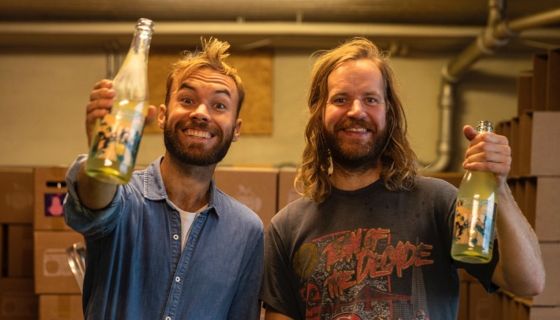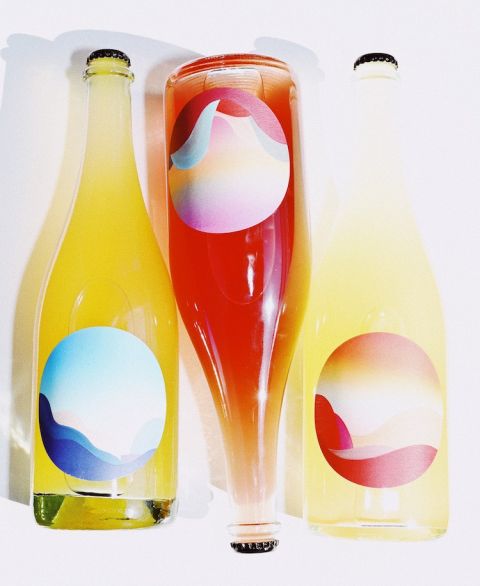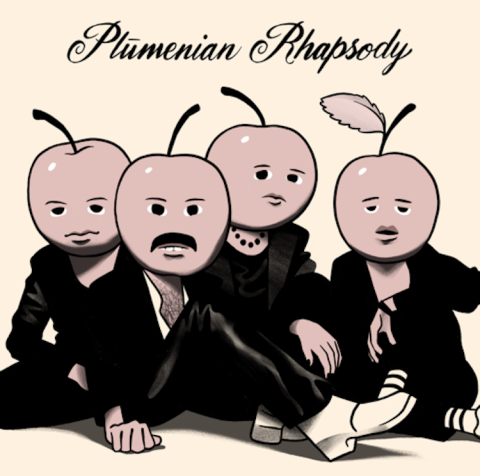21 April 2021 Wine writer Nikki Goddard reports on a host of new, creative ferments that are hybrids of grapes and other fruits. Max Allen adds an Australian coda.
When an industry has been around for 8,000 years, novel ideas tend to be few and far between. But there is a new fruit-wine hybrid movement afoot that is genuinely emblematic of the current moment, and acts as both bellwether and remedy for the changing times. Wine and cider producers are beginning to experiment with making drinks from wine grapes together with other types of fruit – most commonly apples and pears – creating juicy, refreshing drinks that go down like grown-up juice boxes. These fruity fusions are blurring the traditional rules of fermentation and defying categorisation.
It’s difficult to pinpoint where the groundswell began. Historians of both wine and cider struggle to identify a documented precedent for these hybrids, at least on a commercial level. But the sudden growth of the category has been rapid and organic with consumers across demographics being exposed to an increasingly diverse array of alcoholic beverages. The so-called ‘fruit wine’ revolution is not limited to any particular geographical location; it’s a global phenomenon, even in places with limited or recently established wine industries. And although one might expect the new fashion to be met with resistance in countries with long-standing wine traditions, producers in Europe are finding their creations equally well-received at home and abroad, with quite a few of them being exported.
Still in its infancy, the world of fruit wine is a bit of a free-for-all. Production methods vary widely, making it difficult to assign a catchall name to the category. Co-fermentation is perhaps the most popular, but maceration, re-fermentation and blending techniques are commonly seen as well. Co-fermentation is preferred by many producers because it allows each fruit component to share a starring role, rather than highlighting whichever fruit provides the primary fermentable sugar.
Co-fermentation also gives winemakers new flavour combinations to play with. Yuri Zinenko, for example, whose small Melbourne winery Calyx produces a co-ferment of skin-contact Viognier with apples and pears called Grappleare, appreciates the opportunity to incorporate wild yeast strains not typically found among grapes. Occasionally, and perhaps unsurprisingly for a movement defined by a disregard for rules, several of these methods are used in tandem with one another, or combined in double mash-ups with other wine styles such as pet-nat or piquette.
While the craft beer, cider and spirit industries have a longer history of experimenting with grape influences such as ageing in used wine barrels, the more traditional ingredients – the hops, apples or whisky base – were always centre stage. But the new hybrids are not wines tinged with cider nor ciders flavoured with wine; they are something else entirely. ‘Like a chimera in Greek mythology’, Loire Valley winemaker Côme Isambert suggests.
Isambert discovered the co-fermentation technique through Karl Sjöström, who imports his wines into Sweden. Sjöström and his colleague Mikael Nypelius (pictured above), both sommeliers who have worked in fine dining throughout Scandinavia, were early innovators in the category. The first vintage under their Fruktstereo label in 2016 came to fruition (pun intended) when their shared desire to produce wine in their home country was thwarted by the scarcity of local grapes. Determined to ferment something, they turned to apples, pears and other fruits found on abandoned farms and in domestic gardens. The high-end, sustainably-minded restaurants where Sjöström and Nypelius worked had raised their awareness of global and local fruit waste issues. In Sweden about half of the country’s fruit, particularly apples, is thrown away because of imperfections that supposedly make them unsellable.
The luminaries behind Fruktstereo playfully call their creations ‘fruit-nats’ as they are made in a pétillant-naturel style, with secondary fermentation occurring in the bottle as the fruits finish their co-fermentation. Today Fruktstereo is occasionally able to incorporate grapes into the mix, often Swedish-grown hybrids or fruit sourced from their international winemaking friends such as Isambert, who, like many others, was inspired by Fruktstereo’s resourceful and eco-conscious approach. As increasingly challenging vintage conditions in the Loire – frost, hail, drought – threatened Isambert’s grape supply, he considered turning to other fruits. When he discussed his climate concerns with his Swedish friends, Sjöström and Nypelius happily travelled to France in 2017 to help him produce his first vintage of Tour de Fruit from apples and Chenin Blanc.
Climate change has also inspired winemakers on the west coast of the United States to mix things up. Jason Charles opened his urban winery Vinca Minor in Berkeley, California, in 2019. A year later he was facing not only the stresses of a global pandemic, but also the fourth consecutive year of catastrophic wildfires – and in 2020, earlier in the season than ever (see Smoke taint looms large in CA). Charles was hesitant to try his luck at making red wines with potentially smoke-tainted grape skins, and was prepared to almost write the year off. But on a visit to Hawkeye Ranch in Mendocino County, his colleague Cassidy Miller noticed a trough of heritage pears from old orchards. Miller asked Charles, ‘can we ferment these?’
As it turns out, pears and apples are pretty resistant to the damaging effects of smoke; their skins are thicker and less permeable. The orchard fruits turned out to be a saving grace for the young winery, and for Charles, who feared he would have to either give up his long-time vocation or leave California if the fires continued to rage. Under his new Moonlands label, Charles now bottles a line of co-fermented fruit wines that are already outselling his entire Vinca Minor range of wines. The first entry, which combined those serendipitous pears with apples and Mendocino Sauvignon Blanc, tasted upon release of tart green apples, prickly pear and kiwi with a strong herbal undercurrent, developing luscious tropical passion-fruit and guava notes after just two months in bottle.
Meanwhile, in the Napa Valley, Steve and Jill Matthiasson had a different motivation for amalgamating fruit and wine: the COVID-19 pandemic. Sales had slowed dramatically, and the Matthiassons had another dilemma on their hands: what to do with their surplus of peaches they would normally sell to local dining establishments. Since they had long been making a Sauternes-style dessert wine from their flavourful heirloom peaches, they decided to toss them into the press with some Chardonnay, this time fermenting the fruit to full dryness. The lightweight, dry, gently fizzy wine that emerged became an instant favourite with their customers.
The economic considerations for the developing fruit-wine category can be significant, allowing producers to reuse winemaking by-products that would otherwise be discarded (obviously, there are sustainability benefits to this angle as well). Beka Gotsadze of Georgian winery Gotsa uses grape pomace to produce a grappa-style brandy called chacha. Black Lamb, his US importer, didn’t have the appropriate licence to distribute it, so founder Stetson Robbins suggested an alternative use for the leftover grape skins: piquette. Gotsadze put his own spin on it, re-fermenting his intensely concentrated Saperavi grape skins with water and apple juice in qvevri and then bottling the result with lemon juice for a boost of acidity, and fresh grape juice to encourage continued fermentation in bottle, à la pet-nat. The result, dubbed Conscious Exit, is a tart, earthy, herbal beverage with surprising complexity and depth. Its mouth-watering cranberry, rhubarb and pomegranate fruit has a kombucha-like microbial overtone, reminding the drinker that wine is a living organism. But despite its acetic qualities, Conscious Exit is an extremely palatable drink. ‘It is like Coca-Cola’, says Gotsadze. ‘My children drink it.’
Not every producer has entered the fruit-wine scene out of necessity. At Scar of the Sea in San Luis Obispo, California, Mikey Giugni just wanted to have fun with fermentation. A strict oenophile for many years, Giugni discovered the merits of apples when he first tasted serious cider, and soon began producing his own. Later, in 2014, he found himself needing to top off one of his cider barrels. With no remaining apple juice on hand, he thought to add Chardonnay. The synergy between the two fruits surprised him. The grapes contributed useful acidity to the cider, and the apples added texture to the wine. Now, seven years later, Giugni continues to experiment with ingredients and techniques.
While the trend was initially primarily confined to natural-leaning producers, fruit cider is already expanding into the mainstream – sort of. Angry Orchard, the hard cider brand that can claim over half of the US market share in the category, isn’t selling fruit-nats in supermarkets just yet, but its head cider-maker Ryan Burk would be thrilled if they were. Most of Angry Orchard’s cider is made at large facilities in Ohio and Pennsylvania, but the company has a small property in Walden, New York, where Burk’s imagination is allowed to run wild.
A self-proclaimed ‘cider purist’, Burk admits to scoffing at the recent proliferation of rosé-style and hopped ciders, but he sees something special in fruit-wine’s ability to express its origins. For now, production is limited, and bottlings such as Francenstein, a Cabernet Franc/apple co-ferment sourced from two of his most admired local growers, are sold exclusively in the Walden tasting room and through Angry Orchard’s cider club (and to a handful of fortunate restaurateur friends). This fusion of grapes and other fruit feels right to Burk. ‘Ultimately, there’s a blurring of the categories right now’, he says, ‘and the modern drinker is floating between all of them: hard seltzer, cider, wine, beer. So it makes a lot of sense for our industry to do it in a way that is meaningful; that has an intent and purpose, besides just alcohol delivery.’
That blurring of the categories – or cross-pollination, if you will – is likely a result of the growing spirit of collaboration among young, enthusiastic producers, eager to create something alongside their friends in adjacent industries and share their knowledge for the greater good.
Perhaps another reason for the sudden appearance of the fruit-wine category is that, until quite recently, wine and cider have rarely been popular in the same place at the same time. It also seems likely that the increasing acceptance of natural wine has paved the way for the birth of these hybrids. As the movement has gained favour with the mainstream public, as well as within the global winemaking community, the stage has been set for producers to innovate more than ever. As Mike Reis, who co-owns California bottle shop Redfield Cider with his wife Olivia Maki, explains, ‘as consumers show interest, producers start to experiment more … it creates a multiplying effect, and the quality of these beverages just keeps improving’.
It’s no wonder consumers are showing interest. Even the staunchest purist would struggle to dispute that these drinks are downright delicious. And as the NOLO (no alcohol/low alcohol) fad gains in popularity, health-conscious drinkers will find another layer of appeal: most fruit wines clock in at around 8–10% alcohol. And since consumers have been seeing other hybrid drinks such as hopped ciders, wine-barrel whiskies and, rather more unfortunately, whisky-barrel wines on the market for a while now, they might not find these new entries so surprising. And, hey, stranger things have been done to wine. Remember retsina?
Perhaps the biggest challenge for consumers will be actually finding these fruit wines, given that there is no particularly appealing name (nor trending hashtag) for the category. ‘Fruit wines’ is rather bland (and doesn’t necessarily suggest the inclusion of any grapes in the ferment), but labelling regulations inhibit creativity (and also introduce import/export challenges). ‘Hybrid’ and ‘co-ferment’ have other, more common meanings, and the latter term, like ‘fruit-nat’, excludes certain production methods. Some producers use proprietary names as a workaround. Fruktstereo has done this exceptionally well, with aesthetically pleasing labels and clever names inspired by music albums such as Plumenian Rhapsody and The Fruit Pét-Nat Formerly Known as Cider.
Erin Coburn, owner of California natural-wine shop Minimo, shrugs. ‘In the spirit of natural wine rejecting traditional categorisation, maybe we should just embrace this as a delicious, happy pairing of fermented fruits.’ Nor are producers that concerned. Their principal problem is maintaining supply of their wildly popular fruit wines.
These hybrids may even help wine grab market share from the flourishing craft beer and cider movements. Jason Charles figured the Moonlands series would be a hit with the novelty-seeking millennial crowd but, unexpectedly, he observed, ‘I'm seeing 50-year-old men who come to the tasting room because their wives drag them here; they wanted to go to the brewery down the street instead. But then they say, “Oh, this is hitting those sour beer notes that I love”.’ Soon, he's also selling them bottles of Carignan and Cabernet Sauvignon. Of course, this sort of consumer may need a little more education. One satisfied visitor commented to Charles, ‘I really like what you're doing with kombucha’.
If the global pandemic has taught us anything, it’s that an ability to adapt can serve us well in trying times. Few among us know this better than winemakers, whose livelihoods perennially depend on the sometimes cruel, often unpredictable whims of nature – as has been all too evident in frost-hit European vineyards recently. Even before our lives went into lockdown, the wine world was already facing serious challenges. On top of natural disasters, we saw crushing trade tariffs implemented between the US and Europe. The pandemic was yet another significant blow. The fruit-wine movement embodies optimism, giving both producers and consumers a reason to feel excitement again.
The biggest buzzword in wine marketing these days is ‘storytelling’, but so often the repetitive tales of terroir and tradition we read on the backs of labels fall a bit flat. There’s something different about the stories behind these fruit wines, however. They are unique, they are intriguing, and they are deeply human. They are stories of hopefulness, perseverance and resourcefulness. Who among us in this moment can’t relate to a story about turning lemons into lemonade?
The world of wine has always been heavily steeped in tradition and history. But as we stumble out of the haze of 2020 and into the uncanny valley of 2021 – which, in parts of the world, is starting to just vaguely resemble the life we used to know – we might find ourselves a little more open to the unexpected. No one is pouring burgundy or bordeaux down the drain to make room in the cellar for Cabernet-quince co-ferments, but the laissez-faire attitude born of the past year may well trickle down to our wine glasses. If we can work from our beds and get married over Zoom, we may as well let a few orchard fruits into the tank with our grapes.
Additional noteworthy producers
Denmark: Æblerov
Canada: Revel Cider (Ontario)
France: Achilleé (Alsace); Christian Binner (Alsace); Anders Frederik Steen (Ardèche)
Italy: Frederico Orsi (Emilia-Romagna)
Austria: Claus Preisinger
United States: Ashanta (California); Tilted Shed Ciderworks (California); Yamakiri (California); Old Westminster (Maryland); Aaron Burr Cidery (New York); Wild Arc Farm (New York); Art + Science (Oregon); Hiyu Wine Farm (Oregon); Fable Farm Fermentory (Vermont); La Garagista (Vermont)
Max Allen adds about Australia
The wine hybrids that spring to mind here as being driven by similar ideas are the rosés made by Nic Peterkin at LAS Vino in Margaret River using local flowers as the source of yeast/bacteria – steeping blossoms in Pinot juice to initiate fermentation (harking back to Aboriginal fermentation practices, as discussed in my book Intoxicating), and a soon-to-be-released range of grape/barley co-ferment beers made by Bryan Martin at Ravensworth Wines in Canberra in collaboration with Topher Boehm at the adventurous Wildflower Brewing in Sydney.
It came about when Bryan was thinking of what to do with his smoke-tainted 2020 grapes: as I wrote recently in the Financial Review, ‘The theory was that the lower alcohols and different fermentation chemistry in the barley/grape brewing process would result in a much less smoky-tasting drink than if the same grapes were made into wine on their own. And that’s precisely what happened. Despite measurements of smoke-taint compounds in his grapes at harvest of up to 1,200 ppm, Martin says the finished brews measure a negligible 10 ppm.’















